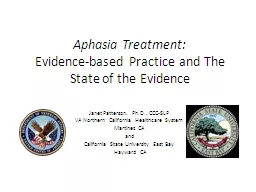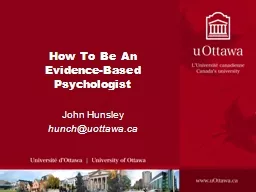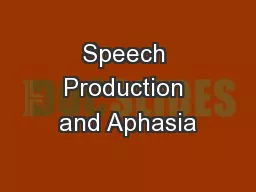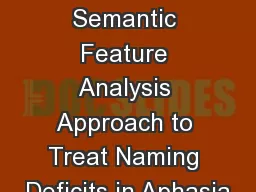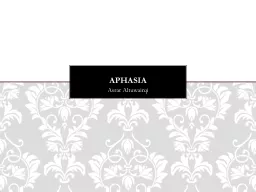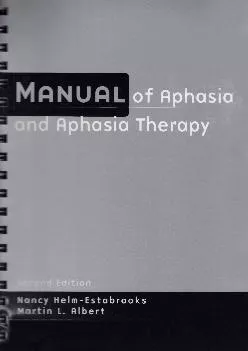PPT-Aphasia Treatment: Evidence-based Practice and The State of the Evidence
Author : nicole | Published Date : 2022-02-15
Janet Patterson PhD CCCSLP VA Northern California Healthcare System Martinez CA and California State University East Bay Hayward CA Objectives Define Evidencebased
Presentation Embed Code
Download Presentation
Download Presentation The PPT/PDF document "Aphasia Treatment: Evidence-based Practi..." is the property of its rightful owner. Permission is granted to download and print the materials on this website for personal, non-commercial use only, and to display it on your personal computer provided you do not modify the materials and that you retain all copyright notices contained in the materials. By downloading content from our website, you accept the terms of this agreement.
Aphasia Treatment: Evidence-based Practice and The State of the Evidence: Transcript
Janet Patterson PhD CCCSLP VA Northern California Healthcare System Martinez CA and California State University East Bay Hayward CA Objectives Define Evidencebased Practice and identify a system for evaluating the strength of the evidence. Qualitative interviews with family members linked to the ICF. Meghann Grawburg. 1. , . Dr. Tami Howe. 1. , . Professor . Linda Worrall. 2. & . Dr. . . Nerina. . Scarinci. 2. 1 . Department . of Communication Disorders, . John Hunsley. hunch@uottawa.ca. OVERVIEW . What Is Evidence-Based Psychological Practice (EBPP). Evidence-base practice, empirically supported treatments, clinical practice guidelines. Examining the research evidence. Speech Production. Includes a selection problem:. Concept. Select from possible words. Motor output. Brain Regions for Speech Production. Wernicke’s. Area. Broca’s. Area. Insula. Wernicke’s. and . to Support Communication . in Aphasia. . Cordelia. Peters, MS, CCC-SLP . Jeannine Alleva, MS, CCC-SLP. BIAMD Conference March 23, 2017. Learning Objectives. Identify 3 different ways to support expression in persons with aphasia (PWA). Naomi Hashimoto. University Wisconsin-River Falls. April, 2011. Word Production Models. CONCEPTUAL LAYER. PHONOLOGICAL LAYER. SYNTACTIC FEATURES. PHONOLOGICAL LEXEMES. PHONEMES. SEMANTIC FEATURES. SEMANTIC FEATURES. What is Aphasia?. Aphasia . type . What . causes . aphasia. Sing . and symptoms . Fact about aphasia. Aphasia assessment. Aphasia . management. Out line . - Acquired. . communication disorder results from damage to portions of the . Formerly Manual of Aphasia Therapy, this second edition is completely revised and updated. Aphasia and its treatment has undergone momentous changes which are refleted in this edition. Since the first edition was published, new technologies for analyzing the neuroanatomy of language have transformed the study of brain-language relations. To understand aphasia, one has to understand its neural basis. In a clinically relevant, straightforward manner, this text describes the neuroanatomical and neuropathologic bases and differential diagnosis of aphasia neurologic, neuropsychologic, and language exams the development of individualized treatment programs the implementation of existing methods and the neuropsychiatric, psychosocial, and legal aspects of aphasia. Completely rewritten chapters and new chapters carry this book into the new century by discussing in detail both functionally-motivated and high-tech approaches to assessment and rehabilitation of aphasia. Speech-language pathologists help people with aphasia with others and participate in everyday life. Over 100,000Canadians live Dr. Sonalika’s Eye Clinic provide the best Glaucoma treatment in Pune, Hadapsar, Amanora, Magarpatta, Mundhwa, Kharadi Rd, Viman Nagar, Wagholi, and Wadgaon Sheri Dr. Sonalika’s Eye Clinic provide the best Corneal disease treatment in Pune, Hadapsar, Amanora, Magarpatta, Mundhwa, Kharadi Rd, Viman Nagar, Wagholi, and Wadgaon Sheri Dr. Sonalika’s Eye Clinic provide the best Low vision aids treatment in Pune, Hadapsar, Amanora, Magarpatta, Mundhwa, Kharadi Rd, Viman Nagar, Wagholi, and Wadgaon Sheri Dr. Sonalika’s Eye Clinic provide the best Paediatric ophthalmology treatment, Paediatric eye checkup treatment in Pune, Hadapsar, Amanora, Magarpatta, Mundhwa, Kharadi Rd, Viman Nagar, Wagholi, and Wadgaon Sheri Dr. Sonalika’s Eye Clinic provide the best Ocular trauma treatment in Pune, Hadapsar, Amanora, Magarpatta, Mundhwa, Kharadi Rd, Viman Nagar, Wagholi, and Wadgaon Sheri Dr. Sonalika’s Eye Clinic provide the best Phaco surgery treatment in Pune, Hadapsar, Amanora, Magarpatta, Mundhwa, Kharadi Rd, Viman Nagar, Wagholi, and Wadgaon Sheri
Download Document
Here is the link to download the presentation.
"Aphasia Treatment: Evidence-based Practice and The State of the Evidence"The content belongs to its owner. You may download and print it for personal use, without modification, and keep all copyright notices. By downloading, you agree to these terms.
Related Documents

